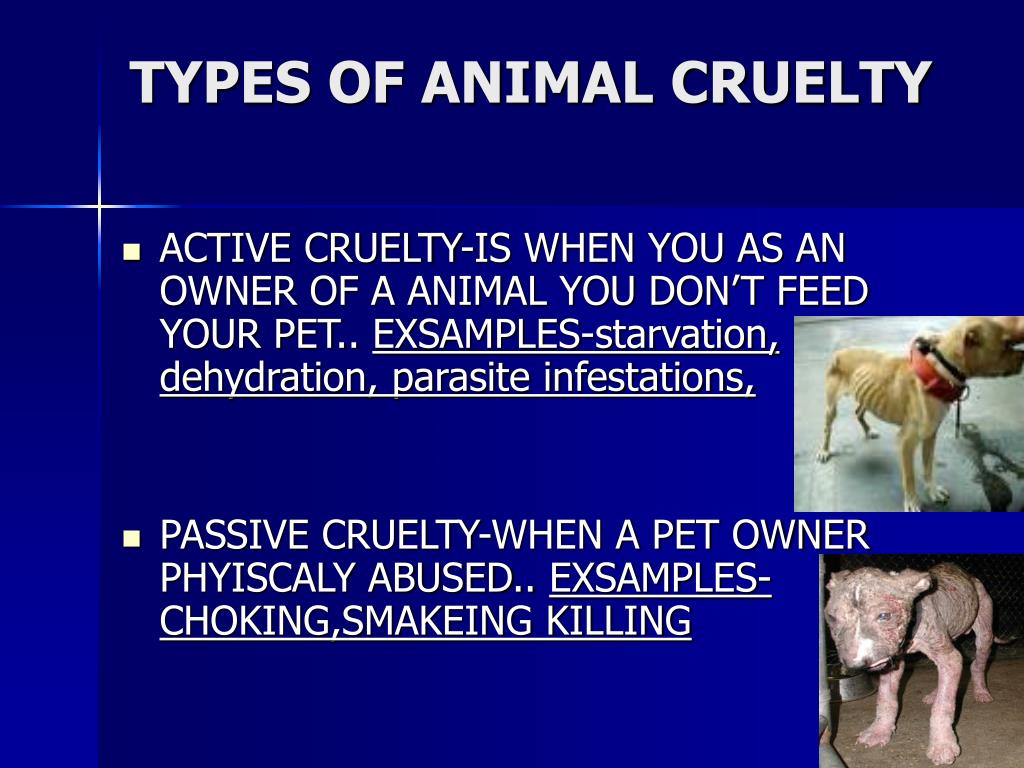Animal cruelty is a grave issue that plagues societies across the globe, manifesting in various forms that often go unnoticed. While we may think of animal kindness as innate, the reality reveals a disturbing trend of neglect and abuse that calls for our attention. What exactly constitutes animal cruelty, and how can we delineate its multifaceted nature? Understanding this issue begins with recognizing the three principal types of animal cruelty: neglect, intentional harm, and corporate mistreatment. Each category presents a unique challenge, demanding thoughtful discourse and rigorous advocacy.
Neglect often emerges as the most insidious form of animal cruelty. Unlike overt acts of violence, neglect is characterized by a failure to provide basic necessities such as food, water, shelter, and medical care. Imagine a dog left tethered outside in freezing temperatures, without access to warmth or sustenance. Such neglect not only endangers the physical well-being of the animal but also hampers its psychological health. Cases abound where well-meaning guardians, overwhelmed by life’s demands, inadvertently place their companions in precarious positions. Consider the story of a kitten found mewing in a vacant lot, severely malnourished and suffering from untreated infections. This example starkly illustrates neglect’s perilous grip and highlights the imperative for awareness and intervention.
Intentional harm, on the other hand, embodies a calculated infliction of suffering. This type of cruelty can manifest through physical abuse, such as beating, kicking, or otherwise harming an animal out of malice or disregard for its suffering. Beyond the immediate physical damage inflicted, intentional harm often cultivates a culture of violence that can extend beyond the animal realm. The case of a puppy abandoned in a dumpster, suffering grave injuries caused by a human’s cruelty, serves as a bleak reminder of the darkness that dwells in some hearts. This reflects not only on the perpetrator’s depravity but also on society’s failure to nurture compassion. In combating this egregious issue, it is crucial to hold offenders accountable and foster environments where empathy becomes paramount.
Corporate mistreatment presents another alarming facet of animal cruelty. This type primarily arises from industries that exploit animals for profit, with little regard for their welfare. Whether in factory farms, laboratories, or entertainment venues, animals often endure abhorrent conditions under the veneer of human convenience and enjoyment. Take, for example, the plight of the cows in intensive dairy farming operations. These animals frequently experience chronic confinement, deprived of natural behaviors and subjected to painful medical procedures, all in the name of efficiency and profit. The controversy surrounding the treatment of elephants in tourism also raises significant ethical questions. Many of these majestic creatures are subjected to rigorous training methods, leading to both physical and psychological torment, merely to entertain tourists. It becomes imperative, therefore, to scrutinize and reform corporate practices that compromise animal welfare for monetary gain.
The challenge posed by these forms of cruelty is multifaceted and demands a robust response. It is essential to recognize that combating animal cruelty is not solely the responsibility of activists or law enforcement but requires collective societal action. Community education plays a critical role here; increasing awareness about animal rights and the implications of neglect or abuse can incite a culture of responsibility. Hosting workshops, creating informative materials, and leveraging social media can catalyze discussions that empower individuals to act when they witness cruelty.
Furthermore, legislation plays a pivotal role in eradicating animal cruelty. Advocates can work towards enacting stricter laws that categorize animal abuse as a serious crime and ensure offenders face significant repercussions. Striving for reform within local, state, and national legal frameworks is essential in reinforcing the protection of animals. Grassroots movements have previously catalyzed meaningful change, driving legislation that bans puppy mills and prohibits certain forms of animal testing.
Each individual can contribute to this cause, whether through volunteering at shelters, adopting rather than purchasing pets, or simply having difficult conversations with friends and family about animal rights. Every action, no matter how small, can contribute to a greater movement against animal cruelty.
As we reflect upon the implications of animal cruelty, consider the following question: Are we content to remain passive observers, or will we emerge as vigilant protectors of those who cannot advocate for themselves? This inquiry underscores a broader challenge facing our society. It beckons each person to engage with the reality of suffering animals and to stand against practices that normalize cruelty. Through awareness, education, and activism, we possess the power to effectuate change and foster a compassionate world for all beings.
The road ahead is undoubtedly long and fraught with obstacles. However, by illuminating the various forms of animal cruelty and advocating for systemic change, we can pave the way toward a future where every creature experiences the respect and dignity it deserves. Let us galvanize our efforts, unite our voices, and combat the tides of cruelty that threaten our compassionate ideals.








